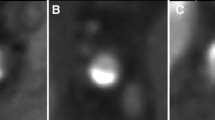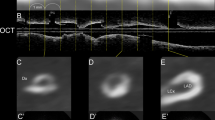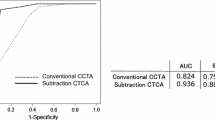Abstract
Background
Two-dimensional axial and manually-oriented reformatted images are traditionally used to analyze coronary data provided by multidetector-row computed tomography angiography (MDCTA). While apparently more accurate in evaluating calcified vessels, 2D methods are time-consuming compared with automated 3D approaches. The purpose of this study was to evaluate the performance of a modified automated 3D approach (using manual vessel isolation and different window and level settings) in a population with high calcium scores who underwent coronary half-millimeter 16-detector-row CT angiography (16×0.5-MDCTA).
Methods
ECG-gated 16×0.5-MDCTA (16×0.5 mm cross-sections, 0.35×0.35×0.35 mm3 isotropic voxels, 400 ms rotation) was performed after injection of iopamidol (120-ml, 300 mg/ml) in 19 consecutive patients (11 male, 62±10 years-old). Native arteries were independently evaluated for ≥50%-stenoses using both manual 2D and modified automated 3D approaches. Stents and bypass grafts were excluded. Conventional coronary angiography was visually analyzed by 2 observers.
Results
Median Agatston calcium score was 434. Sensitivities, specificities, positive and negative predictive values for detection of ≥50% coronary stenoses using the 2D and modified 3D approaches were, respectively: 74%/63%, 76%/80%, 45%/34%, and 91%/93% (p=NS for all comparisons). Overall diagnostic accuracies were 75 and 78%, respectively (p=NS). Uninterpretable vessels were, respectively: 37% (77/209) and 35% (73/209) – p=NS. Time to analyze a single study was 160±23 and 53±11 min, respectively (p<0.01).
Conclusions
This modified automated 3D approach is equivalent to and significantly less time consuming than the traditional manual 2D method for evaluation of ≥50%-stenoses by 16×0.5-MDCTA in native coronary arteries of patients with high calcium scores.
Similar content being viewed by others
Abbreviations
- 16×0.5-MDCTA:
-
half-millimeter 16-detector-row CT angiography
- 2D:
-
two-dimensional
- 3D:
-
three-dimensional
- CAD:
-
coronary artery disease
- CCA:
-
conventional coronary angiography
- CPR:
-
curved multiplanar reformation
- CT:
-
computed tomography
- ECG:
-
electrocardiogram
- HU:
-
Hounsfield units
- JHH:
-
The Johns Hopkins Hospital
- kV:
-
kilovolt
- LAD:
-
left anterior descending
- LCx:
-
left circumflex
- LM:
-
left main
- mA:
-
milliampere
- MDCTA:
-
multidetector-row computed tomography angiography
- MIP:
-
thin-slab maximum intensity projection
- mm:
-
millimeter
- MPR:
-
multiplanar reformation
- ms:
-
millisecond
- RCA:
-
right coronary artery
- s:
-
second
References
Nieman K, Oudkerk M, Rensing BJ, van Ooijen P, Munne A, van Geuns RJ, et al. Coronary angiography with multi-slice computed tomography. Lancet 2001;357(9256):599–603
Nieman K, Cademartiri F, Lemos PA, Raaijmakers R, Pattynama PM, de Feyter PJ. Reliable noninvasive coronary angiography with fast submillimeter multislice spiral computed tomography. Circulation 2002;106(16):2051–4
Ropers D, Baum U, Pohle K, Anders K, Ulzheimer S, Ohnesorge B, et al. Detection of coronary artery stenoses with thin-slice multi-detector row spiral computed tomography and multiplanar reconstruction. Circulation 2003;107(5):664–6
Dewey M, Schnapauff D, Laule M, Lembcke A, Borges AC, Rutsch W, et al. Multislice CT coronary angiography: evaluation of an automatic vessel detection tool. Rofo 2004;176(4):478–83
Agatston AS, Janowitz WR, Hildner FJ, Zusmer NR, Viamonte M, Jr., Detrano R. Quantification of coronary artery calcium using ultrafast computed tomography. J Am Coll Cardiol 1990;15(4):827–32
Rumberger JA, Brundage BH, Rader DJ, Kondos G. Electron beam computed tomographic coronary calcium scanning: a review and guidelines for use in asymptomatic persons. Mayo Clin Proc 1999;74(3):243–52
Dewey M, Laule M, Krug L, Schnapauff D, Rogalla P, Rutsch W, et al. Multisegment and halfscan reconstruction of 16-slice computed tomography for detection of coronary artery stenoses. Invest Radiol 2004;39(4):223–9
Bashore TM, Bates ER, Berger PB, Clark DA, Cusma JT, Dehmer GJ, et al. American College of Cardiology/Society for Cardiac Angiography and Interventions Clinical Expert Consensus Document on cardiac catheterization laboratory standards. A report of the American College of Cardiology Task Force on Clinical Expert Consensus Documents. J Am Coll Cardiol 2001;37(8):2170–214
Schmermund A, Baumgart D, Mohlenkamp S, Kriener P, Pump H, Gronemeyer D, et al. Natural history and topographic pattern of progression of coronary calcification in symptomatic patients: An electron-beam CT study. Arterioscler Thromb Vasc Biol 2001;21(3):421–6
Kuettner A, Kopp AF, Schroeder S, Rieger T, Brunn J, Meisner C, et al. Diagnostic accuracy of multidetector computed tomography coronary angiography in patients with angiographically proven coronary artery disease. J Am Coll Cardiol 2004;43(5):831–9
Hoffmann U, Moselewski F, Cury RC, Ferencik M, Jang IK, Diaz LJ, et al. Predictive value of 16-slice multidetector spiral computed tomography to detect significant obstructive coronary artery disease in patients at high risk for coronary artery disease: patient-versus segment-based analysis. Circulation 2004;110(17):2638–43
Kuettner A, Beck T, Drosch T, Kettering K, Heuschmid M, Burgstahler C, et al. Diagnostic accuracy of noninvasive coronary imaging using 16-detector slice spiral computed tomography with 188 ms temporal resolution. J Am Coll Cardiol 2005;45(1):123–7
Kaiser C, Bremerich J, Haller S, Brunner-La Rocca HP, Bongartz G, Pfisterer M. et al. Limited diagnostic yield of non-invasive coronary angiography by 16-slice multidetector spiral computed tomography in routine patients referred for evaluation of coronary artery disease. Eur Heart J 2005
Acknowledgements
Grant support: this work was funded by the National Institutes on Aging (Bethesda, MD) RO1- AG021570-01 grant, by the Johns Hopkins Reynolds Cardiovascular Center (D. W. Reynolds Foundation, Las Vegas, NV), by the Zerbini Foundation (Fundação E. J. Zerbini, São Paulo, SP, Brazil), and partly supported by Toshiba Medical Systems Corporation (Otawara, Japan). Dr Cordeiro is funded by the Brazilian National Research Council (CNPq, Brasília, DF, Brazil) as a postdoctoral fellow (fellowship grant 202706/02-8) in the Division of Cardiology of The Johns Hopkins University School of Medicine (Baltimore, MD).
Author information
Authors and Affiliations
Corresponding author
Rights and permissions
About this article
Cite this article
Cordeiro, M.A.S., Lardo, A.C., Brito, M.S.V. et al. CT angiography in highly calcified arteries: 2D manual vs. modified automated 3D approach to identify coronary stenoses. Int J Cardiovasc Imaging 22, 507–516 (2006). https://doi.org/10.1007/s10554-005-9044-9
Received:
Accepted:
Published:
Issue Date:
DOI: https://doi.org/10.1007/s10554-005-9044-9




